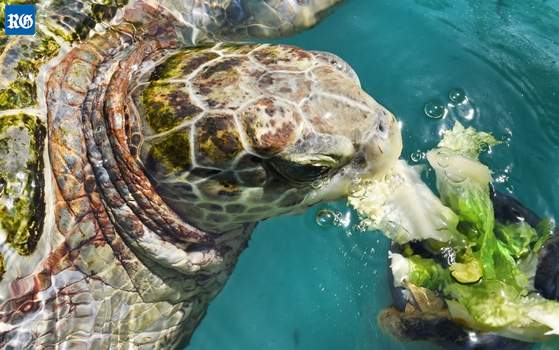All the latest news and updates from the Bermuda Aquarium, Museum & Zoo, one of Bermuda's leading visitor attractions!
Latest News
Government responds to turtle concerns
Owain Johnston-Barnes
Published May 11, 2017 at 12:01 am (Updated May 11, 2017 at 7:21 am)

Government has defended the decision to relocate turtles from the Great Sound during the America’s Cup after questions were raised by Greenrock.
In a statement this afternoon, a spokeswoman for the Ministry of the Environment said: “It is well known in the sea turtle conservation community that where there are turtles and boats, there will be collisions.
“Every year, noticeably during boating season, the BAMZ Wildlife Rehabilitation Centre sees turtle injuries resulting from strikes from marine craft.
“After considering the options, it was decided that the risks to the turtles resulting from collision outweighs the risks associated with a temporary holding period until there is a reduction in boating traffic.”
The plan was initially announced on Sunday, with a statement saying that turtles would be caught in the Great Sound and transported to a purpose-built ocean enclosure near the Bermuda Aquarium Museum and Zoo this month and next.
Jonathan Starling, executive director of Greenrock, responded that while the charity understood the reasoning for the action, it had concerns about the impact of the relocation on the turtles and the wider environment.
Among the specific issues raised by the charity were the risk of the turtles harming each other, spreading illnesses and disruption of the animal’s eating habits.
In their latest statement, government responded to many of the questions, saying that efforts were being made to minimise any impact on the turtles.
“Turtles are currently captured and released annually via netting procedures as part of local research and conservation efforts,” the statement said. “Bermuda has established procedures with experienced personnel. This effort will build on that expertise.
“The turtles will be released inside a purpose-built enclosure. The enclosure has two separate areas to allow separation of individuals by size. Soft material may be tethered tightly to the inside to prevent abrasions, if it is deemed necessary. The turtles will be monitored by trained personnel and qualified veterinarians. The immediate area adjacent to BAMZ is off limits to the public in order to maintain a calm environment for the turtles.
“While in captivity, the turtles in care will be fed lettuce and a special complete diet for sea turtles, as successfully practised at BAMZ and other facilities around the world. They will be bottom fed using trays or tubes to minimise disruptions to their eating habitats and the food will be removed at the end of each feeding session. The costs are being shared by multiple organisations so no one entity carries the burden.”
While the statement acknowledged that it was not possible for all turtles to be removed from the Great Sound, noting that based on visual observations there are likely several hundred sea turtles in the area and more turtles could enter that area after the collection period ends, the spokeswoman adds: “The aim is to try to protect as many turtles as possible.”
Ian Walker, principal curator at BAMZ, said: “Our goal and commitment is to provide the best possible care for these Bermuda’s sea turtles so we can release them back to the wild with as little interruption to their life cycle as possible.”
Meanwhile, Mike Winfield, CEO of ACBDA, added: “It is our sincere hope that the spotlight this shines on the difficulties sea turtles encounter — whether from cast off fishing lines, discarded plastics which they mistake for food, or watercraft — will heighten public awareness about the hazards they face and lead people to make changes to their behaviour.”
The boating public is encouraged to assist in the conservation of sea turtles by travelling at slower speeds and strictly observing no wake zones, and being on the watch for turtles.